Estimated reading time: 23 minutes
Most of us think of netting fruit trees as a way to stop pests like birds and fruit flies from damaging the fruit, and it is. But did you know that netting can also protect fruit from weather events, like frost and hail?
It all depends on what type of net you choose, and autumn is a great time to think about it.
How good is your fruit tree netting?
Autumn is one of the most stunning times of year here on the farm. But it’s not all beautiful sunny weather; we often get quite a bit of rain and even little hailstorms.
That’s not too much of a problem when the trees don’t have fruit. During the fruit season, it’s a different matter. Hail can cause significant damage to your fruit, resulting in the types of injuries you can see on these plums (below).
Whether you’ve previously suffered the pain of hail damage or not, autumn is a good time to do some planning.
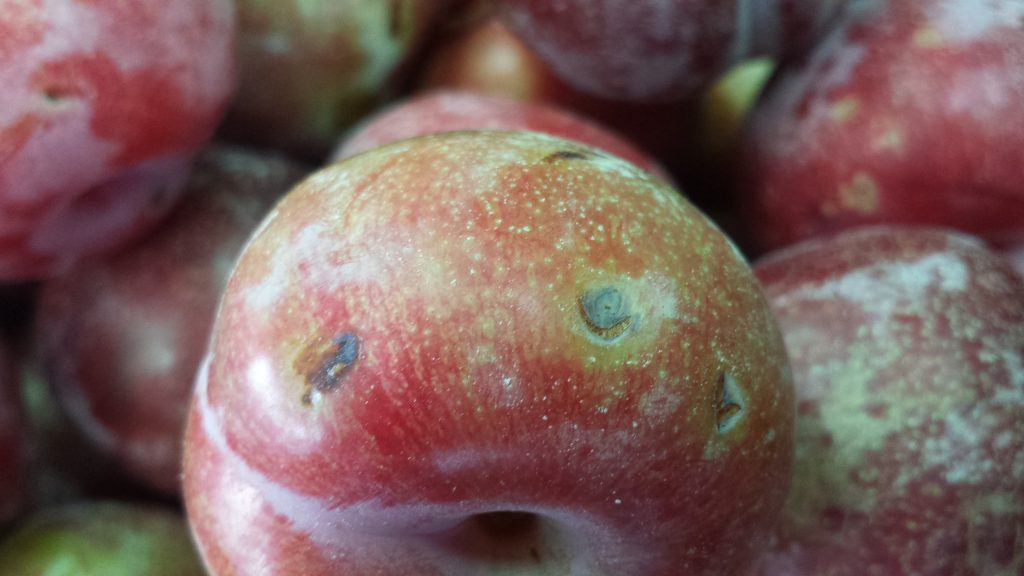
How to review your fruit tree nets
The fruit season is winding down, and you probably have a bit more breathing space to think about how you can use netting to protect your trees against future threats.
To start with, review how your netting (if you have any) performed this season. Think about both the pros and cons:
- Was it easy to manage the infrastructure (either building your netting system or putting out and taking in nets)?
- How well did it protect your fruit from different species of birds?
- How well did it protect the fruit from other animals like bats, possums, rats, kangaroos, foxes, or deer?
- Did it provide any protection from weather events like frost, rain, hail, or storms?
- Was there a negative impact on birds or wildlife?
- Were the fruit or trees damaged by the nets?

What did your netting failures cost you?
Your fruit tree netting might have been a bit of a pain to manage, or not been completely effective.
Maybe you didn’t net at all, for any one of a number of reasons. Netting can be difficult, and deciding to install a system is a big decision, we get it!
But here comes the real convincer (and it’s probably something you don’t want to think about!)
If you didn’t net your trees this year, try to estimate how much fruit you’ve actually lost. It might have been to birds or other animals. Or it might have been the result of weather events that caused damage that might have been preventable with the right protection in place.
Considering that a mature tree can easily produce from 20 to 40 kg of fruit (or even more in some cases), you may well be looking at substantial losses!
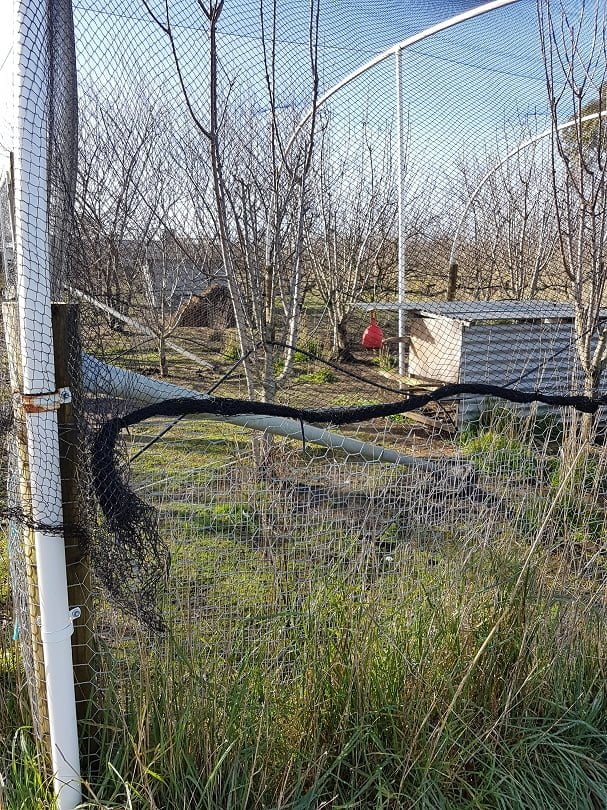
How to tell whether the cost of netting your fruit trees is worth it
Once you have the answers to the above questions, they’ll steer you in the right direction for making some good decisions about how you’ll approach the question of netting your fruit trees next season.
Unless you have a miraculous absence of pests, it’s definitely worth putting protection in place if you can.
Even if you don’t have a lot of pest pressure, hail is an ever-present worry. If you’ve never seen hail damage to peaches, check this out – gruesome, huh?
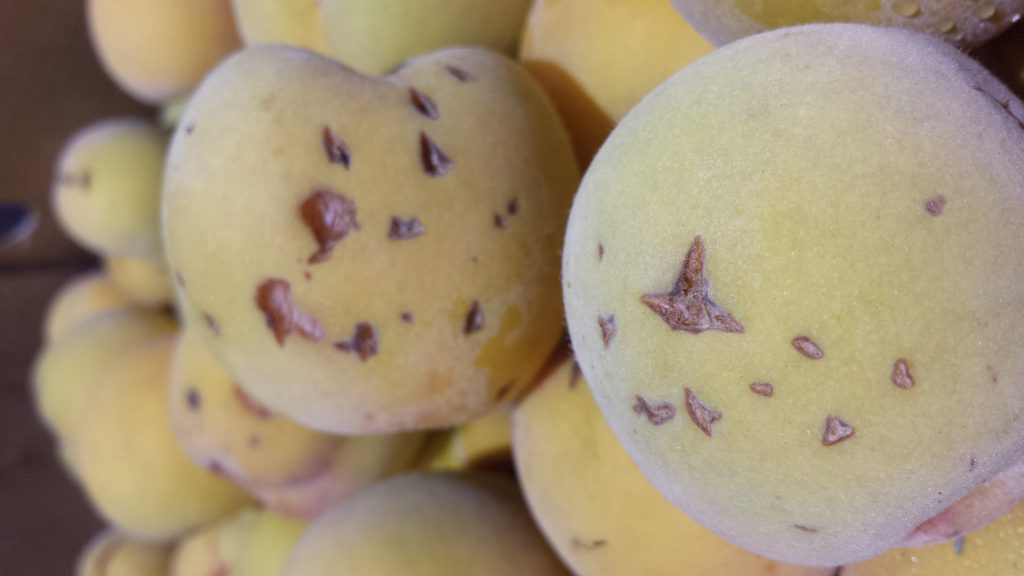
Drape netting vs enclosure netting for hail protection
Our farm is in a fruit-growing area, and it’s becoming increasingly common for commercial orchardists to net their orchards to prevent hail damage as well as bird damage.
Two common methods you can use are a permanent enclosure or drape netting the trees each year. Drape nets are usually removed from the trees and stored under cover over winter.
It’s easy to assume you’ll only get hail protection if you put in a highly engineered (and therefore expensive) permanent structure. Surprisingly, both systems can offer substantial protection against hail.
In fact, drape netting has some advantages – not least of which is it’s much cheaper.
Permanent enclosures can be more easily damaged by hail. We saw this in a really bad hailstorm in Harcourt a few years ago, where the weight of the hailstones caused severe damage to the net of a neighbouring orchard (though to be fair, it did protect the crop underneath).
Drape netting may still result in some fruit on the outside of the tree (where it’s in contact with, or just under the net) being damaged by hail, but actually the net deflects most of the hail and provides pretty good coverage for most of the crop.
Using different types of net on fruit trees
The other big advantage of drape netting is that it’s much more affordable to change the type of net at different times of the year.
For example, you can use fruit fly netting on individual trees when they are vulnerable to attack. Building a whole enclosure out of fruit fly netting would be prohibitively expensive for most home growers.
It’s also possible to use frost cloth over the same frame in spring when the trees are flowering, to protect them from frost.

A simple hoop system to protect your fruit
In our opinion, the best system for both birds and hail is something like the one above. It’s not in contact with the tree, but it also allows the hail to fall off rather than catching it. This system can be as temporary or permanent as you like and the same structure can also be used for frost cloth or fruit fly cloth if needed.
This is a fantastic and affordable system, but it’s not the only type of netting system for home gardeners. The one you’ll choose will ultimately depend on your garden, your budget, and your capacity to build it.
But we can pretty much guarantee that your future self will thank you for installing the most effective system you can manage!
Related Articles
What broke my fruit tree?
Broken fruit trees can be caused by animals eating them, or accidental damage. Identifying the animal is the first step to prevention.
6 Steps to Looking After Fruit Fly and Bird Nets
Fruit fly and bird nets are key to your fruit growing success. These 6 simple steps to look after them properly will help them last longer.
Could grasshoppers be eating your fruit?
Grasshoppers can do damage to fruit and to leaves on your fruit trees, but it’s possible to keep them under control with these strategies.

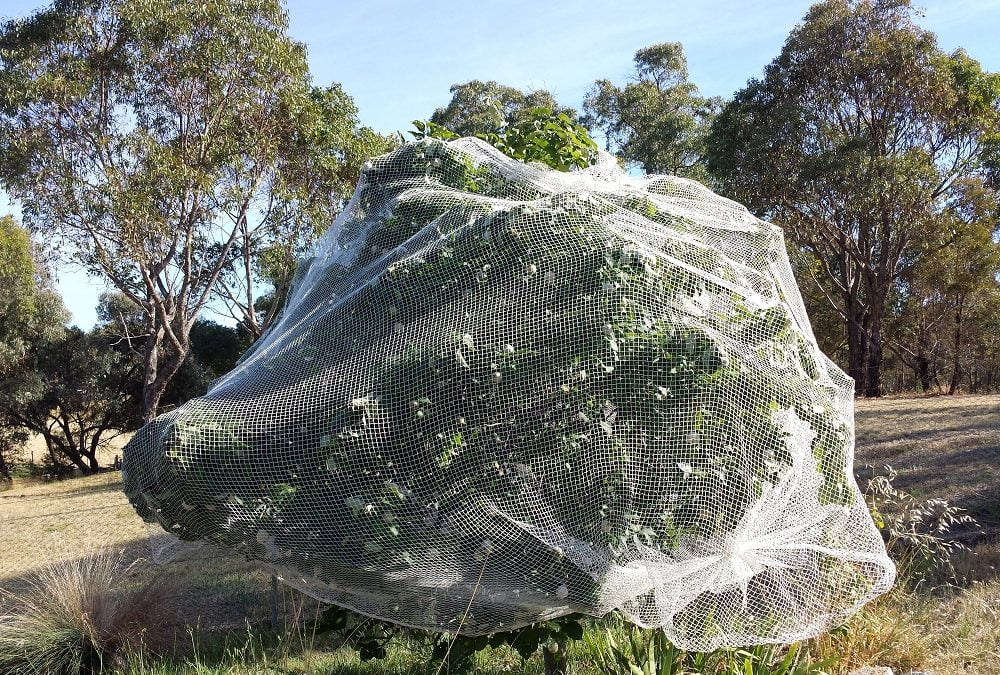


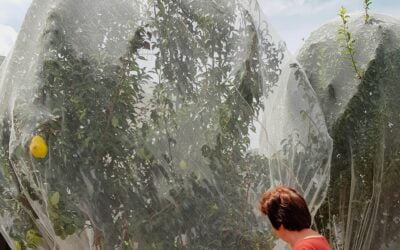



The big poly pipe over the tree in last picture…do you put that over a star picket or stake. My stakes were too big…
Hi Chris – we put 50 mm poly pipe over star pickets, and that system seems to work pretty well.
Thanks for the question.
If a permanent netting enclosure is used bees could not get in to pollinate so how would you overcome this.
If you’re using fruit fly nets, or are in Victoria and must have nets with small holes (less than 5mm) from September 2021, then you’ll need to be able to open or lift part of the net in spring while the trees are flowering. Lots of insects other than European honey bees will also help to pollinise the fruit, and many of them are quite small.
If have found a few of the 9 different apple varieties I have in my front yard will have several ‘flowering’ episode in a season – currently my Granny Smith has finished flowering & has many clumps of 2inch diameter apples currently growing. So I have 2 questions
1) when is the best time to net the fruit tree? After the first flush of flowers have been pollinated?
2) should I remove the unripe apples currently growing (thanks to unusual weather conditions here in Toowoomba) so the tree can go dormant, shall I just leave it there to see what happens?
Last season I had so much enjoyment seeing the rainbow lorikeets & king parrots coming in & feeding on my apples that I decided not to met any of them that year. Somehow I did manage to collect several fruit that where hidden in lower branches that had been left untouched. I won’t do that again though as delightful as it was to watch them they are very wasteful eating chunks out of the apple, not even eating half of it, before moving on to the next one.
My nets will go up next time & as I never have enough nets to cover all trees, the birds can still share some anyway.
Hi Kelly, thanks for the question. Good on you for being able to enjoy watching the birds eat your fruit, that zen approach probably makes you much happier than stressing over it. However, it’s great to see you’re also planning to net the trees. To answer your questions, put the nets up after the first flush of flowering – this is the main one, and these are the flowers that will turn into the best quality fruit. Later flowering, including the end of season flowering you’ve experienced is actually pretty common, and they do sometimes turn into fruit, as you’ve observed, but it rarely comes to anything. Usually the fruit just falls off by itself at the time the tree would normally go dormant. There’s a couple of reasons that pulling this fruit off is still a good idea though – one is that if you have fruit fly you don’t want to provide any food for them late in the season, and the second is that leaving them on the tree might slightly delay the tree going dormant, and with our winters getting warmer and warmer, we need the trees to be dormant for as long as possible.
Oh great. I’ll get to taking the fruit off this week then.
Thanks for the helpful advise 😊
I thought there was new netting laws and the nets in your photos were now illegal? I have the black net over my garden and am worried that the smaller diameter nets will not let the bees in. I will have to do something shortly or cop a fine.
I thought black netting might be illegal as can’t be seen?
Yes, that bird netting will be illegal from September this year……must be a smaller diameter…can’t remember what it is but may be best to just go with fruit fly nets as they’re becoming more of a problem now…Put nets on after blossom so bees have done their job. I use a finer one over vegie boxes but haven’t been really securing it and bees seem to find their way in for flowering rocket etc. Tomatoes can pollinate with wind or movement
Just to clarify, the new laws only apply in Victoria, Australia (we have a global audience, so the nets in the photos will remain legal everywhere else). Commercial growers have an exception to the new laws as well. You’re quite right though Mary, the new nets for backyard growers in Vic must have holes that are 5mm diameter or less, so you’ll need to be able to open/lift the nets in spring to let the bees in when the trees are flowering. As to whether you’ll cop a fine, you’ll have to weigh up how likely it is that you’ll be reported to DWELP, whether they’ll have the resources to follow it up and decide to fine you!
I am a beekeeper and have Katie’s style of poly star picket and netting over raspberries, vege garden and strawberries (I have fruit cage over orchard) but can confirm the bees get through smaller netting just fine. The bees are thick on the raspberries, strawberries and vegetable garden when there is something blooming. We get great crops and pollination and no parrots/cockatoos/kangaroos/deer helping themselves to the buffet.
Great feedback, thanks Kelly – this has been our experience too, it’s good for others to hear it.
What method of Fruit Fly netting in our home orchard, after bad infestation from previous owners?Do I net with FF netting knotted around the trunk, so not to trap new hatching inside the net canopy, with the staking method?
Hi Heather, it’s really important to pick up any fruit from the ground and remove any old fruit from the tree, this will help to minimise any reinfestation. The main infestation in spring actually comes from adults that have over-wintered. They usually do this in warm spaces, but you may want to keep a trap inside the net as well to make sure you catch any adults. This is explained really well in the Fruit Fly Masterclass (https://growgreatfruit.com/product/queensland-fruit-fly-masterclass/). So yes, you can either tie your FF net around the trunk, or you can buy zip-up nets as well. The staking method is also fine as long as you can firmly attach the nets to the ground so fruit fly don’t get in underneath.
Hi, we have one peach tree, one Nectarine and a plum tree , all the subtropical variety about 4 years old. I have netted them with white netting. Secured the net by tying it to the trunk. All was fine till the bats clawed holes into the nets. Rats native or otherwise had a go as well. Ended up with beautiful fruit but by the time they ripened the fruit rotted from the inside. We had not one piece we could eat. Our peach tree is flowering now. What fo I have to spray with against rot etc whilst flowering now, please. Lime sulphur is not good I presume since the flowers are out . Eco product? A solution to the problem much appreciated .
Hi Chris, it’s actually really important to figure out what’s actually making the fruit rot, because the solution needs to be specific to the problem. Rotting from the inside sounds like fruit fly, not Brown rot. The best solution so fruit fly is netting and trapping (check out this fabulous masterclass to learn deeply about fruit fly: https://growgreatfruit.com/product/queensland-fruit-fly-masterclass/). The solution to brown rot is spraying wettable sulphur – but not just routinely spraying, you need to do it at the right time. Learn more about that one in this short course – https://growgreatfruit.com/product/keep-your-fruit-trees-free-from-disease/
In the simple hoop system above for fruit trees protection, what sort of material is used for frame before the net goes on?
Hi Sopo, people use a variety of materials for this, but often a simple star picket with the pipe slotted over it is a very effective solution! Hope that helps, Meg – GGF team.
I have young apple trees, some of which flowered for the first time last spring and gave me a few fruit. I was intending to net them only while they have fruit because I want help from pollinators and insectivores, but this autumn they have been stripped of all their leaves by a possum. Something quite sturdy and seemingly permanent is needed to deal with this adversary. Any suggestions?
Hi geoffrey, grrr, possums are one of the hardest things to deter as they are strong and persistent. Wire mesh or netting is really the best option, but obviously requires a bit of work. No quick and easy deterrent that we know of.